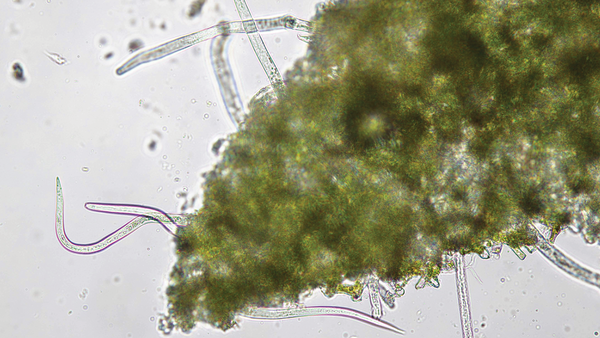
Question: My 30-year-old Harry Lauder’s walking stick (Corylus avellana* ‘Contorta’, Zones 4–8) is starting to die back. Some leaves are chlorotic and then turn brown, with the branch becoming dry and brittle. There are also black spots on some of the branches, which I suspect may be a sign of infection. Can you offer any suggestions for the cause of this problem and any treatment that I can carry out to save this venerable old gentleman?
—Carole Davison, Surrey, British Columbia
Answer: Your vigilance and close inspection of the branches to look for possible signs of infection may yet save your tree, but dealing with the problem may not be quick or easy. There are many causes of branch dieback, including environmental issues and a wide range of different pathogens. However, the combination of this particular plant, your location (Pacific Northwest), and the conspicuous, black, oval-shaped eruptions from the branches strongly point to a diagnosis of eastern filbert blight. This disease, which is caused by the fungus Anisogramma anomala, is prominent in your region and has long plagued hazelnut groves. The fungus is native to North America and causes little harm to American hazelnut (Corylus americana, Zones 4–9), but it results in severe branch dieback on many kinds of European hazelnut, or filbert (C. avellana, Zones 4–8). On Harry Lauder’s walking stick, it can be lethal.
Gardeners dealing with this problem have two main options. The first is primarily for gardeners willing to cut their losses, while the second is for gardeners deeply invested in the tree and who are willing to put in some extra time and expense to keep the damage to a minimum.

Option 1: Consider removing and replacing the plant
I know this sounds harsh! Unfortunately, Harry Lauder’s walking stick happens to be a highly susceptible selection, and curing the tree in the long term is unlikely. If you want to maintain the wonderful winter interest of a contorted European hazelnut in your garden, consider replacing the sick tree, perhaps with ‘Red Dragon’ European hazelnut (C. avellana ‘Red Dragon’, Zones 4–8). This selection not only offers increased resistance to eastern filbert blight, but it is a moderately vigorous grower and boasts deep burgundy foliage.
Option 2: Attempt to manage the disease and keep your tree for as long as possible
After 30 years, I, too, would hate to see a dear old specimen tree go, but be aware that this option is time intensive, and the structural qualities of the tree may be badly affected.
The most challenging part of managing this disease is the latent period. The fungus has a life cycle of two or more years, and it infects new shoots of growth as they emerge every spring; however, you may not see symptoms develop until 12 to 15 months later. By the time you see the blister-like growths on the stem that erupt into the oval-shaped black spots (called stromata), the branch has already been infected for a long time and must be pruned out. If it isn’t, the canker will continue to girdle the branch and each stroma will produce many infectious spores. It is recommended to prune 12 to 35 inches (approximately 30 to 90 centimeters) below these cankers, which can wreak havoc on carefully trained branches. I would start with a minimum of 12 inches down the branch to the nearest suitable location for a pruning cut. Since it is difficult to remember where you saw wilting branches during the summer, try flagging or marking sick branches during the growing season so you can inspect them closely for signs of the fungus during fall or winter.
Finally, you will need to protect the susceptible new growth each season. In Canada, your fungicide options may be limited to copper-based products that need to be applied frequently. At least four applications at a 7- to 14-day interval starting at budbreak may be necessary. Follow the label instructions. Gardeners in the United States may have access to fungicides such as chlorothalonil or propiconazole-based products, which last longer or move into the young tissues, offering superior protection and requiring fewer applications. Remember that some of last spring’s new branches are surely already infected. They will start to show dieback next season and produce stromata eventually. Be vigilant. Prune whenever you see signs of the disease, and burn infected materials. Then sterilize your tools.
Naturally, you can also choose to pursue management for now, while also obtaining a possible replacement to plant elsewhere, such as the more resistant ‘Red Dragon’. It never hurts to have a backup plan.

Elm Zigzag Sawfly
The elm zigzag sawfly (Aproceros leucopoda) is on the move. This invasive pest primarily affects elm trees (Ulmus spp. and cvs., Zones 2–9). It is native to Asia and was first detected in North America in Québec in 2020. It has since been found in Virginia, North Carolina, Maryland, Pennsylvania, New York, and recently in Massachusetts. The larvae of this sawfly feed on elm leaves, causing defoliation. The species is known for
its distinctive zigzagging pattern on the leaves where the larvae feed.
To get the most recent and accurate information on the presence of the elm zigzag sawfly, check with your local agricultural extension office, state forestry department, or other relevant environmental agency. These often provide updates on invasive species and pest management efforts.
*Invasive Alert:
Common filbert (Corylus avellana)
This plant is considered invasive in OR.
Please visit invasiveplantatlas.org for more information.
Matthew Borden, DPM, is a plant health consultant specializing in diagnostics and integrated management of landscape plant pests and diseases. He is based at the Bartlett Tree Research Laboratories in Charlotte, North Carolina.
Find more solutions to your plant problems:
How to Prune Out Diseased Wood


















Comments
Log in or create an account to post a comment.
Sign up Log in